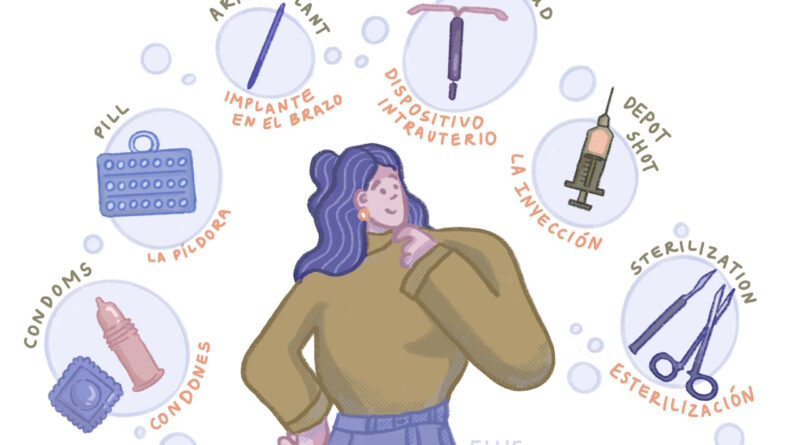Birth Control
Birth Control Basics: The Pill, the Condom, and Everything in Between
by Ananta Wadhwa
According to the Center for Disease Control (CDC), between 2017-2019, approximately 65% of women between the ages of 15-49 in the United States of America were using some type of contraceptive [1]. Contraception – the act of preventing pregnancy – can be achieved using devices, pills, implants, and procedures. The goal is to prevent the egg from meeting sperm if and when a woman is sexually active. Birth control, however, is not only used to prevent pregnancy, as it is also used to regulate the menstrual cycle, ease bleeding, and protect against sexually transmitted infections (STIs) [2]. Contraceptives are always being researched, studied, and improved, leading to new possibilities that can fit with any woman’s needs. There are several options – both older and more novel – currently available on the market. For example, Femlyv, a new pill that was just approved by the Federal Drug Administration (FDA) in 2024, is a norethindrone acetate/ethinyl estradiol tablet that can dissolve on the tongue, making the pill more accessible for people who have trouble swallowing pills [3]. Here are some other options:
United States of America were using some type of contraceptive [1]. Contraception – the act of preventing pregnancy – can be achieved using devices, pills, implants, and procedures. The goal is to prevent the egg from meeting sperm if and when a woman is sexually active. Birth control, however, is not only used to prevent pregnancy, as it is also used to regulate the menstrual cycle, ease bleeding, and protect against sexually transmitted infections (STIs) [2]. Contraceptives are always being researched, studied, and improved, leading to new possibilities that can fit with any woman’s needs. There are several options – both older and more novel – currently available on the market. For example, Femlyv, a new pill that was just approved by the Federal Drug Administration (FDA) in 2024, is a norethindrone acetate/ethinyl estradiol tablet that can dissolve on the tongue, making the pill more accessible for people who have trouble swallowing pills [3]. Here are some other options:
Female Sterilization:
- How It Works: Surgical procedure that blocks the fallopian tubes, is highly effective (99%), and permanent
- Pros: Requires no ongoing maintenance
- Cons: Generally irreversible and involves surgical risks
Long-Acting Reversible Contraceptives (LARC):
Arm Implant:
- How It Works: Hormonal device placed under the skin of the arm, is highly effective (99%), and lasts between 3 to 5 years
- Pros: Requires minimal maintenance once inserted
- Cons: Can cause side effects and has a higher upfront cost
IUD (Hormonal and Copper):
- How It Works: A device placed in the uterus that prevents pregnancy either by hormones or copper, is highly effective (99%), and lasts between 3 to 10 years
- Pros: Requires minimal maintenance once inserted
- Cons: May cause irregular bleeding and requires a procedure for insertion that may be painful
Short-Term Reversible Contraceptives (SARC):
Pill:
- How It Works: Oral hormones that prevent ovulation, is highly effective (99%), and requires daily ingestion
- Pros: Can also help regulate menstrual cycles.
- Cons: Requires daily use and may cause side effects
Barriers – Male/Female Condom:
- How It Works: A physical barrier that prevents sperm from entering the vagina
- Pros: Provides STI protection too and is easy to obtain
- Cons: Effectiveness can be affected by incorrect use
Use of contraceptives varies based on age, race, and ethnicity. Contraceptive use increases with age, peaking at about 75% between ages 40- 49 vs 39% between ages 15-19 [1]. Furthermore, non-Hispanic white women are more likely to be using contraceptives when compared to Hispanic women (69.2% vs 60.9%), but condom-usage rates are higher in Hispanic women (10.5% vs 7.0%) [1]. It is key to consider cultural norms and religion when thinking about what sort of contraceptive to use along with a woman’s individual needs and wants. Also, using two forms of contraceptives – like the pill and a condom – is the most effective for preventing pregnancy. Talk to your doctor or check out this website for more information [4].
49 vs 39% between ages 15-19 [1]. Furthermore, non-Hispanic white women are more likely to be using contraceptives when compared to Hispanic women (69.2% vs 60.9%), but condom-usage rates are higher in Hispanic women (10.5% vs 7.0%) [1]. It is key to consider cultural norms and religion when thinking about what sort of contraceptive to use along with a woman’s individual needs and wants. Also, using two forms of contraceptives – like the pill and a condom – is the most effective for preventing pregnancy. Talk to your doctor or check out this website for more information [4].
Images: Illustration by Ellie Cheng.
Works Cited:
[1] Daniels K, Abma JC. Current contraceptive status among women aged 15–49: United States, 2017–2019. NCHS Data Brief, no 388. Hyattsville, MD: National Center for Health Statistics. 2020.
[2] FDA Office of Women’s Health. Birth Control. FDA. 2024.
[3] Ernst, Diana. Dissolvable Birth Control Pill Femlyv Gets FDA Approval. 2024.
[4] https://www.bedsider.org/birth-control
 Ananta Wadhwa is a 2nd year medical student at the University of Rochester. She is from Westchester County, NY but she lived in Los Angeles for 5 years before coming to medical school. She went to UCLA for her undergraduate degree in Molecular, Cell, Developmental Biology and Musicology. She is interested in women’s health, maternal and fetal medicine, and working with diverse communities as a physician. She is a member of the Latinx Health Pathway at URSMD. Outside of medicine, she enjoys working out, rock climbing, listening to music, and petting every dog she sees on the street.
Ananta Wadhwa is a 2nd year medical student at the University of Rochester. She is from Westchester County, NY but she lived in Los Angeles for 5 years before coming to medical school. She went to UCLA for her undergraduate degree in Molecular, Cell, Developmental Biology and Musicology. She is interested in women’s health, maternal and fetal medicine, and working with diverse communities as a physician. She is a member of the Latinx Health Pathway at URSMD. Outside of medicine, she enjoys working out, rock climbing, listening to music, and petting every dog she sees on the street.

